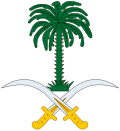
Back الدولة السعودية الثالثة Arabic Tercer Estado saudita Spanish Troisième État saoudien French تیسری سعودی ریاست Urdu
This article needs additional citations for verification. (April 2025) |
Third Saudi State الدولة السعودية الثالثة (Arabic) | |||||||||||
|---|---|---|---|---|---|---|---|---|---|---|---|
| Motto: لا إله إلا الله، محمد رسول الله Lā ilāha illa allāh, Muḥammadun rasūlu allāh "There is no god but Allah, Muhammad is the Messenger of God"[1][a] (shahada) | |||||||||||
| Anthem: النشيد الوطني السعودي "an-Našīd al-Waṭaniyy as-Suʿūdiyy" "Chant of the Saudi Nation" | |||||||||||
 Map of the countries that established the third Saudi state:
Emirate of Riyadh (1902–1913) Emirate of Nejd and Hasa (1913–1921) Sultanate of Nejd (1921–1926) Kingdom of Hejaz and Nejd (1926–1932) Kingdom of Saudi Arabia (1932–present) | |||||||||||
| Capital and largest city | Riyadh 24°39′N 46°46′E / 24.650°N 46.767°E | ||||||||||
| Official languages | Arabic[5] | ||||||||||
| Common languages | Arabic | ||||||||||
| Religion | Sunni Islam (official)[6] | ||||||||||
| Demonym(s) |
| ||||||||||
| Government | Absolute monarchy | ||||||||||
| |||||||||||
The Third Saudi state is the heir to the two earlier Saudi states: the first and the second, founded by Abdul Aziz bin Abdul Rahman (also known as "Ibn Saud"), who managed to capture the city of Riyadh on January 13, 1902. A long series of conflicts and conquests ultimately led to the establishment of the modern and contemporary Saudi state, the Kingdom of Saudi Arabia.
- ^ "About Saudi Arabia: Facts and figures". The Royal Embassy of Saudi Arabia, Washington, DC. Archived from the original on 17 April 2012.
- ^ "God". Islam: Empire of Faith. PBS. Archived from the original on 27 March 2014. Retrieved 3 September 2017.
- ^ 'Islam and Christianity', Encyclopedia of Christianity (2001): Arabic-speaking Christians and Jews also refer to God as Allah.
- ^ L. Gardet. "Allah". Encyclopaedia of Islam Online.
- ^ "Basic Law of Governance". Ministry of Education. Ministry of Education – Kingdom of Saudi Arabia. Archived from the original on 5 December 2022. Retrieved 1 September 2020.
- ^ "Saudi Arabia" (PDF). U.S. Department of State.
According to the basic law, Sunni Islam is the official religion and the country's constitution is the Qur'an and the Sunna (traditions and sayings of the Prophet Muhammad).
Cite error: There are <ref group=lower-alpha> tags or {{efn}} templates on this page, but the references will not show without a {{reflist|group=lower-alpha}} template or {{notelist}} template (see the help page).
© MMXXIII Rich X Search. We shall prevail. All rights reserved. Rich X Search

